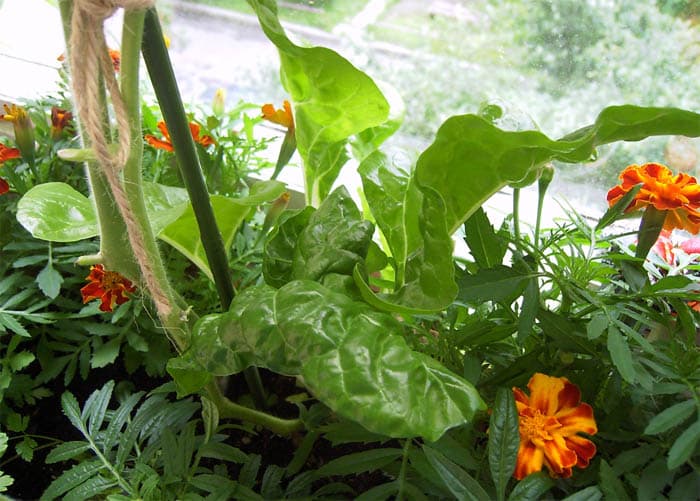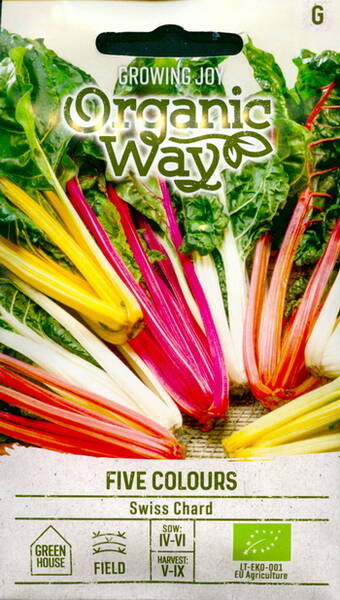Ex Tax: 1.50€
Organic seeds for a healthier life.
* Preparing chard seeds for sowing.
The seeds, tested for germination, are soaked in one of the following nutrient solutions:
— 1/4 teaspoon of boric acid and 0.5 teaspoon of nitrophoska or nitroammophoska are dissolved in 1 liter of warm water (30°C); the seeds are kept in cloth bags for 12 hours;
— 1 teaspoon of superphosphate is dissolved in 1 liter of warm water (30°C); the seeds are kept in the solution for 24 hours;
— 1 teaspoon of baking soda is dissolved in 1 liter of water; the seeds are kept in the solution for 24 hours;
— 1 tablespoon of wood ash is dissolved in 1 liter of water; the seeds are kept in the solution for 24 hours.
After soaking the seeds in any of the selected solutions, they are taken out, rinsed with water, covered with a damp cloth and kept for 2-3 days. To prevent the seeds from drying out, they are moistened as needed, while ensuring that the temperature is not lower than +20°C.
Preparing the site and sowing seeds in the ground.
Mangold is not very demanding of soil. However, it prefers sandy loam, light and medium loamy soils. And in terms of acidity - slightly acidic or neutral. Poor sandy and heavy clay soils are not quite to the chard's taste. This crop does not require manure, but uses it very well, so it can be grown both in the first and second year after its application. It is very important to deeply loosen the soil in the fall, since leaf beet has a very long root.
Beets occupy the bed throughout the gardening season. It cannot be sown two years in a row in the same place, it cannot be grown after spinach and sugar beets.
The best predecessors are: potatoes, cucumbers, onions, for which organic fertilizers were added.
The bed is prepared 6-10 days in advance. It is limed: either 2 cups of dolomite flour or 1 cup of slaked lime (or chalk) are added per 1 sq. m. Before sowing, 1-2 cups of wood ash and microelements are added per 1 sq. m. To do this, take 1 tablet of microelements (crushed into powder), 1 teaspoon of magnesium sulfate, 0.5 teaspoon of boric acid, mix everything with 1 cup of sand and evenly scatter over 1 sq. m of the bed.
On average, 1 g contains 40-55 seeds. This amount is enough for an area of 1 sq. m.
The width between rows depends on the purpose of cultivation. If leaves are collected, the distance between rows should be 25-30 cm, if petioles - at least 40 cm.
Leaf beet is sown in furrows or in nests. The distance between the "nests" is 15-20 cm for leaf varieties and 40 cm for petiolate varieties. The planting depth is 2-3 cm.
Swiss chard is a cold-resistant plant. Seeds begin to sprout at a temperature of +6+7°C. However, frosts (up to -3°C) can damage the seedlings. The optimal temperature for plant growth and development is +17+23°C.
Swiss chard is sown annually, but, sprinkled with earth and covered with spruce branches, it can overwinter in the ground. New shoots will appear in the spring.
Swiss chard can be grown as a second crop. In this case, it is sown in the last days of August - the first days of September, just like in April. For the winter, the plants are sprinkled with soil and covered with needles. The following year, the leaves are collected until mid-summer, until the plant forms a seed shoot.
Care, watering, feeding and harvesting.
Mangold is not very demanding in terms of care. Since the leaf beet seed is a ball-shaped fruit, which contains 2-3 or more seeds enclosed in a common shell, the swiss chard crops need to be thinned. The first thinning is carried out when 2-3 true leaves develop (15 cm are left between plants in a row). The second thinning is done two weeks after the first. The distance between plants when thinning petiolate varieties is left at 40 cm, leafy varieties - 25-30 cm. After the second thinning, it is advisable to feed the swiss chard (1-2 g of urea, 1-2 g of superphosphate, 2 g of potassium salt per 1 sq. m). Or you can use any ready-made nutrient mixture at the rate of 2-4 g per 1 sq. m. The vegetation period of leafy varieties is 2 months, petiolate varieties - 3 months. During the vegetation period, mangold requires regular watering and loosening (although we note that its soil moisture requirements are moderate).
Attention! Regular watering promotes the formation of juicy, large leaves and tender petioles.
The harvest is carried out in several stages. First, the lower leaves are cut off. However, some of the lower leaves must be left on the plant so that it does not become depleted.
Attention! When cutting leaves, be careful not to damage the central growth point!
It is not recommended to cut more than 1/4 of all the leaves of the plant at a time. In order for the leaves to grow better in the future, it is advisable to feed the chard with nitrogen fertilizers after each harvest. Plants are fed at the rate of 100-150 g per 1 sq. m. This rate is applied 4-5 times in the form of a 0.3% nitrogen solution. After each harvest, be sure to feed and water the plants generously (15-20 liters per 1 sq. m). And after watering, when the soil dries out a little, loosen it. If you have chosen leafy chard varieties, use young, not fully unfolded leaves. They are prepared in the same way as spinach. They need to be cut 1-2 cm from the root, without touching the core leaves. Before collecting petiolate varieties, you should wait until the leaves have fully unfolded.
Growing mangold in winter.
To grow chard indoors in winter, you need to dig up the roots of the plant from the bed in the fall, then select those with a well-developed and viable bud on the head, as well as those with a "main" thick root. Pour the soil mixture into the box and plant the selected plants, placing the root crops close to each other. Sprinkle them with soil and water with settled water at room temperature.
Attention! When sprinkling the roots of chard with soil, make sure that the central bud of each head is 2 cm above the soil layer. During winter forcing, chard should be fed 2-3 times under the root with nitrogen fertilizers (do not get the solution on the leaves!). Usually, on the 20-25th day after planting the roots, you can collect the first harvest. Cut only the outer leaves, then the central parts will grow greenery more intensively. Do not water abundantly and often. The water temperature should not be higher than +22°C. Loosening has a very beneficial effect on the development of plants.
The yield of chard leaves and petioles in indoor conditions can reach 6 kg per 1 m2.

Spinach Beet. Bot.: Beta cicla L., Beta vulgaris L. var. vulgaris.
* How to choose vegetables and fruits with a minimum amount of nitrates?
Human health largely depends on proper nutrition. Fresh vegetables, fruits and greens are necessary for the body to function normally. They are the basis of a healthy diet - this is a real storehouse of minerals, vitamins and antioxidants. But, as you know, all plants can absorb not only useful substances from the soil...
Recently, many people have become concerned about the presence of nitrates in them. As a result of numerous studies, scientists have come to the conclusion that the problem is not the presence of nitrates in products, but their quantity.
What are nitrates?
Nitrates are salts of nitric acid that get into vegetables and fruits from the soil. They are necessary for plants to grow better and have a good harvest. No one would have paid attention to their content, but increased concern has appeared since the time when in agriculture they began to intensively feed plants with nitrate fertilizers to increase the harvest. As a result, people began to have health problems, because the consumption of products with a high content of nitrates became precisely this provocateur...
Harm from nitrates.
Nitrates themselves are not considered harmful, but when they enter the body in large quantities, they can be converted into toxic nitrines. With an increased content of nitrates in vegetables, the supply of oxygen to the body can decrease. As a result, the nervous system is weakened and metabolism is disrupted. The amount of iodine can also decrease, which leads to problems with the thyroid gland. A concentrated dose of nitrates reduces the intake of vitamins - this can also lead to problems with the intestinal microflora.
Signs of nitrate poisoning: dizziness, nausea, vomiting, diarrhea, loss of consciousness and an enlarged liver.
According to the World Health Organization, 5 mg of nitrates per 1 kg of human body weight is considered a harmless norm. Therefore, an adult can easily consume about 350-400 mg of nitrates per day.
How can you protect yourself from getting excess nitrates into your body?
Tip #1: find the source of nitrates.
Increased nitrate content can be found in early vegetables and fruits grown in greenhouses. They are most often grown with the addition of fertilizers and special supplements.
If you know the "dangerous" places where they accumulate the most, you can reduce their intake into the body: most often this can be the base of the fruit and leaf stalks ("vessels" of plants).
For example:
- the stems of parsley, dill and celery accumulate several times more nitrates than the leaves
- the cabbage stalk contains more nitrates than the leaves (by 35%)
- the pulp of radishes and cucumbers contains much less nitrates than the tail and peel
- the inflorescences of cauliflower are considered safer than the stems
- about 80% of nitrates accumulate in the core of carrots.
Tip #2: take a closer look at the product.
Only some signs of increased nitrate content can be determined by appearance, but this is not possible by smell.
But still, pay attention to some indicators that may indirectly indicate an increased dose of nitrates:
- beets and carrots have a whitish core
- watermelons have yellowish veins
- zucchini, potatoes and cucumbers with yellow spots under the skin...
There is also a general recommendation for choosing vegetables: it is better to buy them in smaller sizes, since large specimens can simply be overfed with fertilizers.
Tip #3: use special devices.
To detect increased nitrate levels, there are special devices - nitrate meters.
This is a small device with a digital or arrow panel, which displays data on the amount of nitrates in products. There are both professional and household models.
Tip #4: choose vegetables and fruits according to season.
Greenhouse vegetables and fruits usually have a higher nitrate content, so it is better to wait until they ripen seasonally: then there is a chance that they will have fewer nitrates. Moreover, ripe fruits always contain fewer nitrates than unripe ones. (Cabbage, radish, greens, beets can accumulate the most nitrates, while sweet peppers, tomatoes, eggplants, peas, garlic and onions have a lower nitrate content. Round radishes have fewer than elongated ones).
Tip #5: cook food properly.
When chopping and grinding food, the amount of nitrates increases. Especially if they are left at room temperature for a long time.
That is why it is recommended to prepare salads immediately before the meal, season them with fermented milk products (low-fat) and lemon juice, since folic acid, ascorbic acid and vitamin E, which are found in these products, can significantly reduce the effect of nitrates.
And fatty dressings in the form of mayonnaise and vegetable oil, on the contrary, can increase the conversion of nitrates into nitrines.
* Salting, fermentation and preservation can significantly reduce the effect of nitrates.
More recommendations:
- cut off the top leaves of cabbage and do not use the stalk
- cut off the tops and ends of the root vegetables of carrots and beets
- cut off the stalks of cucumbers and zucchini (it is also advisable to peel them, because this is where the most nitrates accumulate).
- remove the thick bottom part of leeks
- melons and watermelons have the most nitrates in the peel, so don't "overdo it" in eating the pulp that is adjacent to it
- store vegetables and fruits in the refrigerator, since low temperatures do not allow nitrates to be converted into nitrines
- get rid of spoiled products immediately
- it is recommended to soak vegetables and fruits in water for 15-20 minutes (especially leafy greens)
- in order to protect yourself from nitrates, cucumbers should be peeled and the ends cut off before eating (by the way, many people mistakenly believe that bitter cucumbers contain nitrates, but the bitterness of cucumbers has nothing to do with the chemistry in vegetables!)
- before buying tomatoes, ask the seller to make a cut: if the pulp of a tomato is lighter than its skin, then most likely such a fruit contains a large the amount of nitrates, and a thick skin and the presence of white veins can also indicate nitrates. - many dark spots on cabbage leaves are a sure sign of the presence of nitrates, because black spots and spots on cabbage are a fungus that loves nitrate vegetables the most...
- remove the top 3-5 cabbage leaves before eating
- it is the most difficult to identify nitrate potatoes, since such tubers are almost visually indistinguishable from safe potatoes...
(the texture of the tuber can indirectly indicate the presence of nitrates: to do this, pierce the potato with your fingernail, if you hear a distinct crunch, then such a potato can be taken, but if the nail goes into the fruit "like clockwork", then it is better to refrain from buying such a potato.
- do not forget to thoroughly wash and peel vegetables. This is especially true for early vegetables, which contain the most nitrates.
- remember that even peeled vegetables contain approximately 15-20% nitrates. Get rid of these "harmful "nitrates" can be removed by regular soaking, since nitrate salts dissolve well in water. Therefore, before eating or cooking, it is advisable to soak vegetables in a large volume of water (for 20-30 minutes). And even better, vegetables are freed from harmful elements during cooking: up to 40% of nitrates disappear from cabbage, and up to 80% from potatoes!
- if you are not sure of the "environmental friendliness" and safety of purchased vegetables, then it is better to eat them only after cooking, despite the fact that baked or boiled fruits contain less useful substances, but the effect of "chemistry" on the body is significantly reduced.
- all vegetables that are subject to long-term storage (potatoes, carrots, cabbage, beets, etc.) lose up to 50% of nitrates in 2.5-3 months. - 5 times more nitrates accumulate in the peel of fruits than in the pulp.
- a ripe fruit contains much fewer harmful substances than an unripe one.
- the less fresh the fruit, the fewer vitamins and antioxidants it contains.
- try to plan your purchases in the morning, thereby increasing the likelihood that the vegetables bought at the market or in the store are fresher.
- when choosing vegetables, pay attention to the green "tails" and stems - whether they have dried out, as well as the elasticity of the leaves and peel.
- lemon, cranberries, apples, lingonberries - contain a large amount of antioxidants, so try to dress all your salads with them.
- there are vegetables that are less susceptible to the accumulation of nitrates.
These include: onions, eggplants, garlic, legumes, zucchini. Grapes also absorb significantly fewer harmful substances than other fruits.
- all vegetables that are subject to long-term storage (potatoes, carrots, cabbage, beets, etc.) lose up to 50% of nitrates in 2.5-3 months.
- it is not advisable to buy large root crops, since it is the large size that may indicate that the producer "did not skimp on chemicals" when growing this crop...












